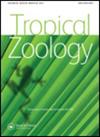芬尼松松鼠的色觉:明显的皮毛颜色对物种识别有用吗?
IF 0.7
4区 生物学
Q4 ZOOLOGY
引用次数: 5
摘要
芬莱森的松鼠芬莱森松鼠分布在整个东南亚的低地森林中。它的群岛颜色明显且多态(红色、黑色、白色和这些颜色的混合物),这是该物种的特征,根据群岛颜色模式描述了16个亚种。两个亲缘关系密切的物种,棕色的C.erytraeus和橙色的C.caniceps,也分布在整个地区。为了检验明显的pelage颜色是否是物种/亚种辨别的视觉线索,我们对C.finlaysonii的色觉进行了实验评估。光学测量的鳍背体的颜色在芬莱索尼C.finlaysonii的七个亚种之间差异很大,该地区的三个物种之间也存在差异。色觉测试表明,芬莱索尼氏C.finlaysonii可以区分同种白色、黑色和红色的犬科C.caniceps的橙色。它们也可以区分赤藓类的棕色天竺鼠和同种的白色和黑色天竺鼠,但它们不能区分棕色和红色天竺鼠,因为它们有双色视觉。白色、黑色和橙色可能是Callosciurus物种/亚种识别的有用线索。本文章由计算机程序翻译,如有差异,请以英文原文为准。
Colour vision in Finlayson’s squirrel (Callosciurus finlaysonii): is conspicuous pelage colour useful for species recognition?
Finlayson’s squirrel, Callosciurus finlaysonii, is distributed in lowland forests throughout South-East Asia. Its pelage colour is conspicuous and polymorphic (red, black, white and a mixture of these colours), which is characteristic of the species, with 16 subspecies described based on pelage colour patterns. Two closely related species, the brown C. erythraeus and the orange C. caniceps, are also distributed throughout the region. To examine whether the conspicuous pelage colour is a visual clue for species/subspecies discrimination, we experimentally assessed the colour vision of C. finlaysonii. Optically measured pelage colours of the dorsal body differed greatly among seven subspecies of C. finlaysonii and also differed among the three species of the region. Colour vision tests revealed that C. finlaysonii can discriminate the colour of conspecific white, black, and red pelages from the orange pelages of C. caniceps. They can also discriminate the brown pelages of C. erythraeus and conspecific white and black pelages, but they cannot discriminate between the brown and red pelages because they have dichromatic colour vision. White, black and orange pelage colours could be useful clues for species/subspecies recognition in Callosciurus.
求助全文
通过发布文献求助,成功后即可免费获取论文全文。
去求助
来源期刊

Tropical Zoology
生物-动物学
CiteScore
2.50
自引率
0.00%
发文量
1
审稿时长
>12 weeks
期刊介绍:
Tropical Zoology is an international zoological journal publishing original papers in the field of systematics, biogeography, phylogeny, ecology and conservation of all terrestrial and aquatic animal Phyla from tropical and subtropical areas.
Only papers with new information, high quality and broad interest are considered. Single species description and checklists are not normally accepted. Review papers are welcome. The journal is owned by the Istituto di Ricerca sugli Ecosistemi Terrestri of the Consiglio Nazionale delle Ricerche, Florence, Italy (CNR-IRET) who performs research into the structure and functioning of aquatic and terrestrial ecosystems, focusing in particular on anthropogenic pressure and global change. The knowledge amassed forms the scientific basis for identifying the most appropriate protective and corrective interventions, and provides support for the bodies entrusted with formulating policies for environmental protection and recovery.
 求助内容:
求助内容: 应助结果提醒方式:
应助结果提醒方式:


